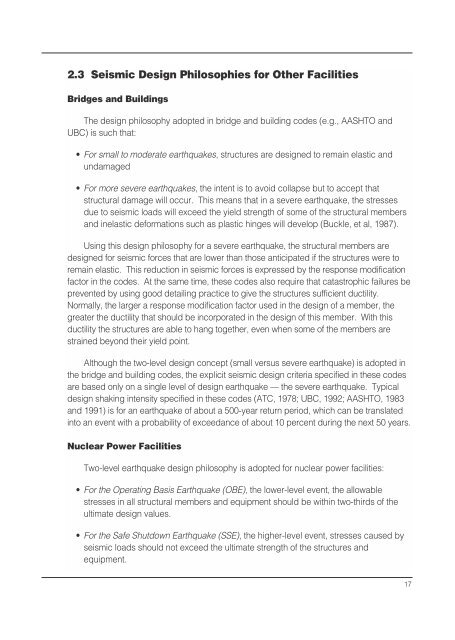Seismic Design of Tunnels - Parsons Brinckerhoff
Seismic Design of Tunnels - Parsons Brinckerhoff
Seismic Design of Tunnels - Parsons Brinckerhoff
You also want an ePaper? Increase the reach of your titles
YUMPU automatically turns print PDFs into web optimized ePapers that Google loves.
2.3 <strong>Seismic</strong> <strong>Design</strong> Philosophies for Other Facilities<br />
Bridges and Buildings<br />
The design philosophy adopted in bridge and building codes (e.g., AASHTO and<br />
UBC) is such that:<br />
• For small to moderate earthquakes, structures are designed to remain elastic and<br />
undamaged<br />
• For more severe earthquakes, the intent is to avoid collapse but to accept that<br />
structural damage will occur. This means that in a severe earthquake, the stresses<br />
due to seismic loads will exceed the yield strength <strong>of</strong> some <strong>of</strong> the structural members<br />
and inelastic deformations such as plastic hinges will develop (Buckle, et al, 1987).<br />
Using this design philosophy for a severe earthquake, the structural members are<br />
designed for seismic forces that are lower than those anticipated if the structures were to<br />
remain elastic. This reduction in seismic forces is expressed by the response modification<br />
factor in the codes. At the same time, these codes also require that catastrophic failures be<br />
prevented by using good detailing practice to give the structures sufficient ductility.<br />
Normally, the larger a response modification factor used in the design <strong>of</strong> a member, the<br />
greater the ductility that should be incorporated in the design <strong>of</strong> this member. With this<br />
ductility the structures are able to hang together, even when some <strong>of</strong> the members are<br />
strained beyond their yield point.<br />
Although the two-level design concept (small versus severe earthquake) is adopted in<br />
the bridge and building codes, the explicit seismic design criteria specified in these codes<br />
are based only on a single level <strong>of</strong> design earthquake — the severe earthquake. Typical<br />
design shaking intensity specified in these codes (ATC, 1978; UBC, 1992; AASHTO, 1983<br />
and 1991) is for an earthquake <strong>of</strong> about a 500-year return period, which can be translated<br />
into an event with a probability <strong>of</strong> exceedance <strong>of</strong> about 10 percent during the next 50 years.<br />
Nuclear Power Facilities<br />
Two-level earthquake design philosophy is adopted for nuclear power facilities:<br />
• For the Operating Basis Earthquake (OBE), the lower-level event, the allowable<br />
stresses in all structural members and equipment should be within two-thirds <strong>of</strong> the<br />
ultimate design values.<br />
• For the Safe Shutdown Earthquake (SSE), the higher-level event, stresses caused by<br />
seismic loads should not exceed the ultimate strength <strong>of</strong> the structures and<br />
equipment.<br />
17
















